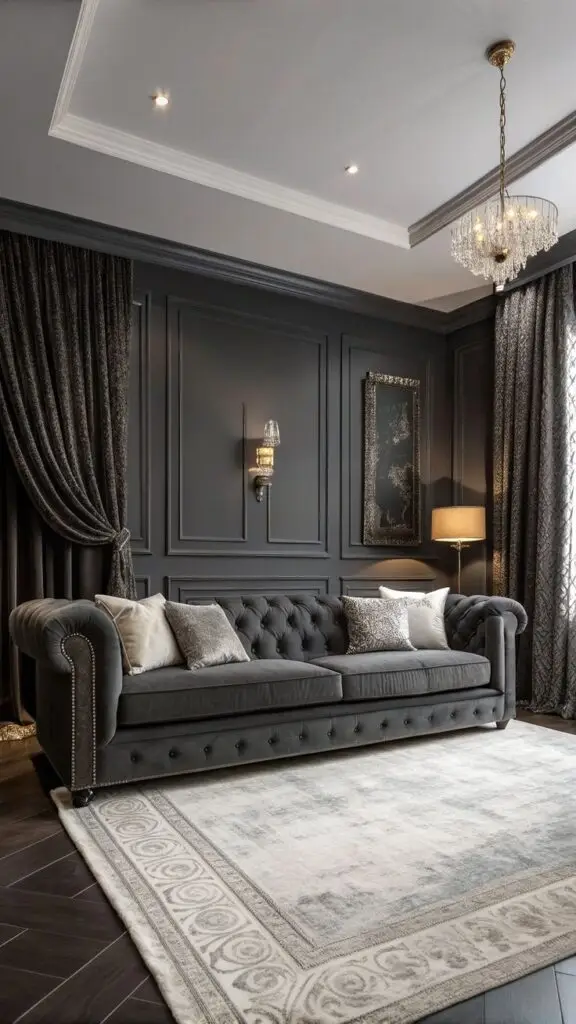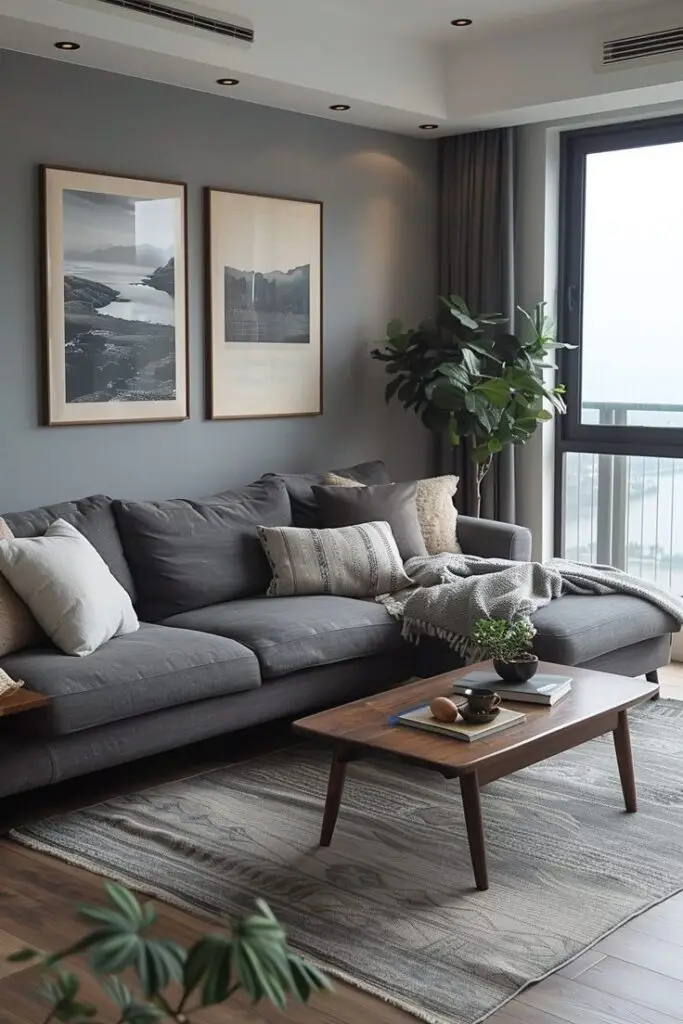When it comes to increasing your home’s perceived value, color selection plays a crucial role in creating that luxury feel. The right palette can transform an ordinary space into one that exudes elegance and sophistication, often without requiring a significant financial investment.
Choosing strategic colors can make your house look thousands of dollars more expensive while costing only a fraction of that amount in paint. Professional designers regularly rely on specific color schemes to elevate interiors and exteriors alike, creating visual impact that impresses both guests and potential buyers. You’ll be surprised how these designer-approved hues can instantly upgrade your home’s appearance.
1) Greige
Greige is the sophisticated blend of gray and beige that designers swear by for creating an expensive-looking home. This versatile neutral strikes the perfect balance between warmth and coolness, making it a go-to choice for upscale interiors.
You’ll find that greige works beautifully in virtually any room and complements most architectural styles. It pairs wonderfully with both warm and cool accent colors, giving you flexibility when selecting furniture and décor pieces.
Consider painting your main living spaces in greige to instantly elevate your home’s perceived value. The color creates a subtle backdrop that makes furnishings and artwork stand out without competing for attention.
For the most luxurious look, choose greige shades with complex undertones. These sophisticated variations appear to change slightly throughout the day as lighting shifts, adding depth and interest to your walls.
When selecting greige paint, test samples in your space before committing. The way greige appears can vary dramatically based on your home’s natural light and existing elements like flooring and trim.


2) Soft Taupe
Soft taupe is a sophisticated neutral that instantly elevates any home’s appearance. This elegant blend of gray and brown creates a warm, welcoming atmosphere while maintaining a distinctly upscale feel.
Designers often recommend soft taupe for its versatility and timeless appeal. You can use it throughout your home as a foundation color that pairs beautifully with both cool and warm accent colors.
What makes soft taupe particularly luxurious is its subtle depth and complexity. Unlike flat beiges, taupe has undertones that shift slightly with changing light, creating visual interest throughout the day.
You’ll find this color especially effective in living rooms and entryways, where it creates an immediate impression of refinement. It works wonderfully with natural materials like wood, stone, and linen to enhance their organic beauty.
For maximum impact, pair soft taupe walls with white trim to create crisp definition. This simple contrast technique is a favorite among high-end designers for creating spaces that feel both polished and inviting.


3) Warm White
Warm white is a designer’s secret weapon when it comes to creating a luxurious atmosphere in your home. Unlike stark whites that can feel clinical, warm whites have subtle undertones of cream, beige, or yellow that create a soft, inviting ambiance.
These sophisticated neutrals work beautifully in any room and pair effortlessly with both traditional and contemporary décor. You’ll find that warm whites like Benjamin Moore’s “Swiss Coffee” or Sherwin-Williams’ “Alabaster” create a sense of subtle elegance without trying too hard.
The magic of warm white lies in how it interacts with light. During the day, these shades reflect natural sunlight beautifully, making spaces feel bright and airy. In the evening, they take on a cozy glow that instantly makes your home feel more welcoming and upscale.
Try using warm white on walls and trim for a cohesive look that enlarges your space visually. You can also incorporate warm whites through furniture pieces, curtains, and accessories to build a layered, thoughtfully designed space.
Remember that lighting dramatically affects how warm whites appear, so test your paint choices under both natural and artificial lighting before committing.


4) Pale Sage
Pale sage is quickly becoming a designer favorite for creating an upscale look without overwhelming your space. This soft, muted green brings natural elegance to any room and creates a sophisticated atmosphere that feels both current and timeless.
You’ll find this gentle hue pairs beautifully with both warm and cool tones, making it incredibly versatile for different design styles. Try combining pale sage with creamy whites and natural woods for a look that’s both refined and welcoming.
This shade works wonderfully in bedrooms and living spaces where you want to create a sense of calm luxury. Many designers recommend pale sage for its ability to make smaller spaces feel larger and more expensive.
When selecting your pale sage paint, opt for formulations with gray undertones for the most sophisticated result. This subtle choice signals design knowledge and intentionality that elevates your home’s perceived value.
Consider using this color in rooms with good natural light to appreciate its subtle depth and complexity. Your guests will notice the thoughtful ambiance without necessarily identifying the exact color that created it.


5) Dusty Blue
Dusty blue is a sophisticated choice that instantly elevates your home’s appearance. This muted blue-gray hue strikes the perfect balance between classic and contemporary, making it a designer favorite for creating expensive-looking spaces.
You’ll find that dusty blue works beautifully in both interior and exterior applications. When used on exterior walls, it creates a distinctive yet refined look that stands out elegantly among neighboring homes.
In living areas, this color creates a serene, upscale atmosphere that feels both welcoming and luxurious. Try pairing dusty blue with crisp white trim and warm wood accents to maximize its elegant impact.
For a truly high-end look, consider incorporating brass or gold fixtures alongside your dusty blue walls. This color combination exudes sophistication and has become a signature pairing in luxury homes.
Designers recommend using dusty blue in bedrooms too, where it fosters a tranquil retreat atmosphere. You can amplify this effect with plush white bedding and subtle metallic accents for a hotel-like experience.


6) Charcoal Gray
Charcoal gray has become a designer favorite for creating sophisticated and expensive-looking homes. This deep, rich hue offers a modern alternative to traditional neutrals while still maintaining versatility across various design styles.
You can use charcoal gray as an accent color on exterior trim, doors, or shutters to create striking contrast against lighter walls. For a bold statement, consider painting your entire home exterior in this elegant shade, which pairs beautifully with natural materials like wood and stone.
Inside your home, charcoal gray walls can transform ordinary spaces into luxurious retreats. The color works exceptionally well in living rooms, dining rooms, and home offices where you want to create a sense of depth and refinement.
When decorating with charcoal gray, balance is key. Incorporate lighter elements through furniture, artwork, and accessories to prevent the space from feeling too dark or heavy.
This sophisticated shade also pairs wonderfully with metallic accents like brass or chrome. These reflective elements will catch the light and add an additional layer of luxury to your charcoal gray spaces.


Understanding Color Psychology
Colors evoke emotional responses and shape our perception of spaces. The strategic use of color can dramatically alter how we perceive a room’s value and aesthetic appeal.
The Impact of Warm Colors
Warm colors like reds, oranges, and yellows create an inviting atmosphere that draws people in. These hues can make your space feel more intimate and cozy, perfect for areas where you entertain guests or gather with family.
Red, when used as an accent, signals luxury and passion. It can make architectural details pop and create focal points that suggest thoughtful design.
Golden yellows and rich ambers evoke a sense of opulence reminiscent of royal decor. These colors reflect light beautifully, making spaces appear sun-drenched and meticulously maintained.
Terracotta and burnt orange tones bring earthy sophistication that feels both timeless and current. They work wonderfully in transitional spaces where you want to create a sense of flow and continuity.
The Influence of Cool Colors
Cool colors like blues, greens, and purples tend to create a sense of calm and spaciousness. They can make your rooms appear larger and more polished, contributing to that high-end feel.
Soft blues reminiscent of clear skies or tranquil waters bring a sense of serenity and cleanliness. These shades work beautifully in bedrooms and bathrooms, creating a spa-like atmosphere that feels luxurious.
Deep navy acts as a sophisticated neutral that pairs beautifully with metallic accents. You’ll find this color in many designer showcases for its ability to create dramatic depth.
Sage and olive greens connect your space to nature while maintaining an upscale appearance. These colors have historical associations with wealth and create a timeless backdrop for art and furnishings.
Lavender and muted purples suggest creativity and refinement when used thoughtfully. These hues catch the light differently throughout the day, creating dynamic spaces that feel curated.
Choosing Complementary Accents
The right accent colors can elevate your expensive-looking color scheme, creating depth and visual interest throughout your home. Strategic color pairings and metallic finishes can transform even the most basic spaces into sophisticated environments.
Balancing Bold and Neutral Tones
When working with neutral wall colors like greige, taupe, or soft white, introduce bold accents through furniture and accessories. Try adding emerald green throw pillows or a navy blue ottoman to create eye-catching focal points.
Mix textures alongside colors to enhance the luxurious feel. Velvet, silk, and linen in complementary hues add dimension without overwhelming the space.
Remember the 60-30-10 rule for color distribution: 60% dominant color (walls), 30% secondary color (furniture), and 10% accent color (accessories). This balanced approach feels intentional and designed.
Don’t forget that art pieces can introduce complementary colors in a sophisticated way. Select artwork that pulls colors from your main palette for a cohesive look.
Using Metallics for Elegance
Metallic finishes act as neutrals that add instant glamour to your color scheme. Gold and brass pair beautifully with deep blues, greens, and rich neutrals, creating a warm, inviting atmosphere.
Silver and chrome complement cool tones like gray, white, and blue, offering a crisp, modern aesthetic. For a contemporary twist, mix metallic finishes deliberately rather than matching everything.
Consider these strategic metallic placements:
- Light fixtures and hardware (doorknobs, drawer pulls)
- Mirror and picture frames
- Small accent furniture (side tables, bar carts)
- Decorative objects and trays
Use metallics sparingly to maintain elegance. One statement piece, like a gold-framed mirror or silver table lamp, creates more impact than numerous small metallic items scattered throughout the room.
- 232shares
- Facebook0
- Pinterest232
- Twitter0


